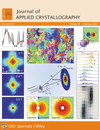issue contents
Magnetic small-angle neutron scattering – from nanoscale magnetism to long-range magnetic structures
Edited by Sabrina Disch, Sebastian Mühlbauer, Andreas Michels and Elliot Paul Gilbert
This virtual special issue of Journal of Applied Crystallography brings together 16 articles representing the cutting-edge work of around 80 individual co-authors; it showcases the breadth of magnetic SANS across the full gamut of magnetic nanostructures and identifies recent and future trends, as well as instrumentation capabilities and novel simulation tools.

Cover illustration: Some images from the special issue Magnetic small-angle neutron scattering – from nanoscale magnetism to long-range magnetic structures. Courtesy of Bender et al. [J. Appl. Cryst. (2022), 55, 586–591], Ulbricht et al. [J. Appl. Cryst. (2022), 55, 702–712], Azarova et al. [J. Appl. Cryst. (2023), 56, 36–43], Mettus et al. [J. Appl. Cryst. (2022), 55, 1603–1612], Barnsley et al. [J. Appl. Cryst. (2022), 55, 1592–1602], Karube et al. [J. Appl. Cryst. (2022), 55, 1392–1400] and Bersweiler et al. [J. Appl. Cryst. (2022), 55, 713–721].

 access
access access
access access
access access
access access
access access
access access
access access
access access
access access
access access
access access
access
 journal menu
journal menu
































